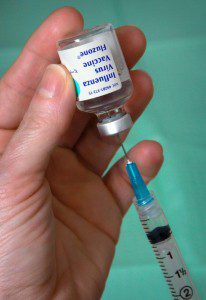

According to the company, testing of the vaccine in 4,080 adult and elderly (>65 years) US individuals has revealed that a half dose (3.75 micrograms) without adjuvant “fulfilled immune response criteria associated with protection”. I assume that the latter statement means that hemagglutination inhibition titers of 1:40 or greater were observed, but this is not explicitly stated. Current US guidelines for the 2009 H1N1 2009 vaccine stipulate that adolescents, adults and the elderly should receive one 15 microgram dose, and children 9 years of age and under are required to receive two 15 microgram doses four weeks apart.
Fluvirin with MF59 adjuvant was also tested in children ages 3 to 8, adults ages 18 to 64, and the elderly. The results indicate that a single 3.75 microgram dose of vaccine with adjuvant induced protective levels of immunity. The media release includes the following:
Novartis proprietary MF59 adjuvant has an established safety profile, supported by more than 12 years of clinical safety data and more than 45 million doses of commercial use in Europe. The adjuvant has been studied in clinical trials involving more than 33,000 people, including children, and has been licensed for use in people 65 years of age and over in the seasonal influenza vaccine Fluad® since 1997 in the European Union. Novartis also produces two A(H1N1) vaccines, Focetria® and Celtura®, which contain MF59 and are available outside the US.
MF59 adjuvant contains squalene, polyoxyethylene sorbitan monooleate (Tween 80) and sorbitan trioleate. No vaccine containing this adjuvant has been approved for use in the US.
A media release is no substitute for revealing clinical trial results in a peer-reviewed scientific journal. Novartis indicates that the vaccine trial will be completed in December 2009, and the results should be published shortly thereafter. It’s important for vaccine manufacturers to make clinical trial data freely available to address the concerns of those who are worried about vaccine safety.

Hi Vincent,
Quick question: Why four weeks apart? Is there some special reason for this, and what if it is five weeks apart, or more, or less? How do they determine the spacing? Thanks, T
Hi Trine,
Immune responses peak in ~3 weeks, therefore 4 weeks is used just to be safe. See figure in https://virology.ws/2009/07/22/adaptive-immu…. You want to wait for the primary response to be over before boosting.
I think a lot of parents who had a hard time getting their kids the first dose may find it difficult to get their kids the booster four weeks later. For many kids, it will be many weeks after that. How protected are the kids until they get that second immunization?
Pingback: Tweets that mention Novartis influenza A H1N1 vaccine clinical data -- Topsy.com
According to the Novartis results, one shot of a half-dose provides
protective immunity. So the kids should be protected after one dose if
they received the Novartis vaccine. The vaccines of the other
manufacturers haven't been tested at half dose, so we don't know if
they would be fully protective. But I think some protection would be
conferred, at least to make the disease milder if acquired.
hi,
there are news about H1N1 vaccine getting side effects like swelling, rashes and fever happening recently. So how do these clinical trial prove to us that they are really safe?
What is the different between (Influza A) H1N1 vaccine and the normal influza vaccine?
Please advise. Thank you.
The 'normal' influenza vaccine, or the seasonal vaccine, consists of
three different viruses: seasonal H1N1 and H3N2, and an influenza B
virus strain. It is made in the same way as the 2009 H1N1 vaccine; the
only difference is that vaccine contains only one virus, the pandemic
H1N1 strain. Side effects such as swelling at the injection site,
fever, and rashes were reported in the clinical trial and are not
unexpected when the vaccine is used in the general population.
Clinical trials cannot prove that a vaccine is 100% safe; but they can
provide information on commonly occurring side effects.
Pingback: Novartis influenza A H1N1 vaccine clinical data | H3N2FLU.US
hi, the side effect which happened recently is not those small swelling at the injection side, but is the swelling of tongue, and the swelling of the whole leg. These seems to be quite serious to me. May I know is this kind of swelling consider as dangerous?
What is the different in the H1N1 vaccine produce by Novartis and GSK or other company? How do we know which Vaccine is safer?
hi, the side effect which happened recently is not those small swelling at the injection side, but is the swelling of tongue, and the swelling of the whole leg. These seems to be quite serious to me. May I know is this kind of swelling consider as dangerous?
What is the different in the H1N1 vaccine produce by Novartis and GSK or other company? How do we know which Vaccine is safer?